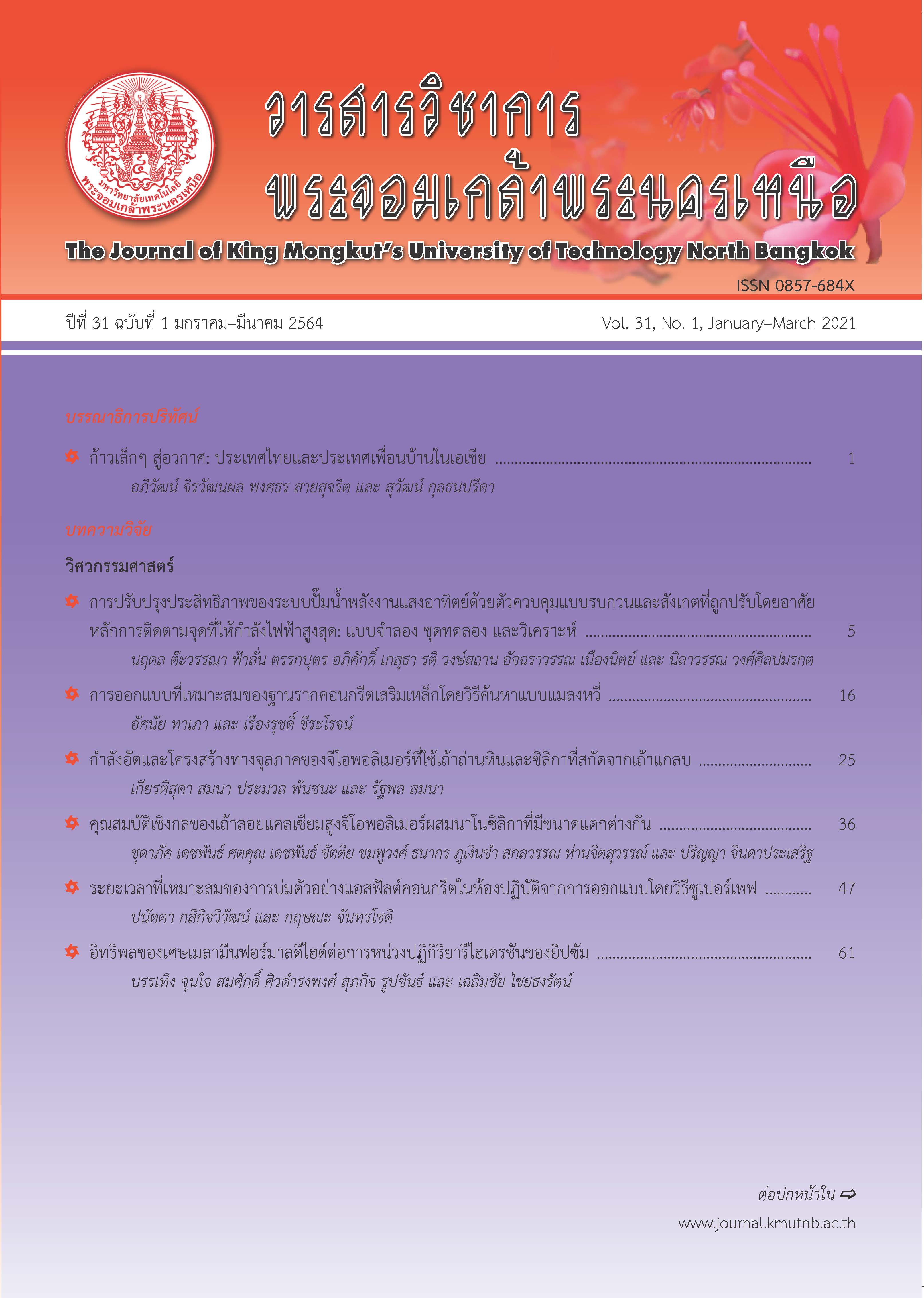คุณสมบัติเชิงกลของเถ้าลอยแคลเซียมสูงจีโอพอลิเมอร์ผสมนาโนซิลิกาที่มีขนาดแตกต่างกัน
Main Article Content
บทคัดย่อ
งานวิจัยนี้นำเสนอการใช้นาโนซิลิกาที่มีขนาดอนุภาคแตกต่างกันเป็นสารผสมเพิ่มต่อคุณสมบัติเชิงกลของเถ้าลอยแคลเซียมสูงจีโอพอลิเมอร์เพสต์ นาโนซิลิกาถูกเพิ่มเข้าไปในเถ้าลอยแคลเซียมสูงร้อยละ 0, 1, 2 และ 3 โดยน้ำหนักของวัสดุประสาน โดยใช้สารละลายโซเดียมซิลิเกตและสารละลายโซเดียมไฮดรอกไซด์เป็นตัวทำปฏิกิริยาในส่วนผสม และใช้ความเข้มข้นของสารละลายโซเดียมไฮดรอกไซด์เท่ากับ 10 โมลาร์ อัตราส่วนสารละลายโซเดียมซิลิเกตต่อสารละลายโซเดียมไฮดรอกไซด์เท่ากับ 2.0 อัตราส่วนของเหลวต่อวัสดุประสานเท่ากับ 0.60 และบ่มที่อุณหภูมิห้องทุกอัตราส่วนผสม โดยทำการทดสอบระยะเวลาก่อตัว กำลังรับแรงอัด กำลังรับแรงดัด มอดุลัสยืดหยุ่น และกำลังรับแรงเฉือนอัดของเถ้าลอยแคลเซียมสูงจีโอพอลิเมอร์เพสต์ ผลการทดสอบแสดงให้เห็นว่า ระยะเวลาการก่อตัวมีแนวโน้มลดลงตามปริมาณการใช้นาโนซิลิกาเป็นสารผสมเพิ่มที่เพิ่มขึ้น กำลังอัด กำลังดัด มอดุลัสยืดหยุ่น และกำลังรับแรงเฉือนอัดของเถ้าลอยแคลเซียมสูงจีโอพอลิเมอร์เพสต์มีแนวโน้มเพิ่มขึ้นตามปริมาณการใช้นาโนซิลิกาจนถึงปริมาณการใช้ที่เหมาะสมยกเว้นนาโนซิลิกาที่มีขนาด 150 นาโนเมตร ซึ่งผลการทดสอบแสดงให้เห็นว่า นาโนซิลิกาที่มีขนาด 150 นาโนเมตร ร้อยละ 3 ยังคงสามารถพัฒนาคุณสมบัติเชิงกลของเถ้าลอยแคลเซียมสูงจีโอพอลิเมอร์เพสต์ได้จากผลการทดสอบข้างต้นสามารถสรุปได้ว่า การใช้นาโนซิลิกาที่มีขนาด 12 และ 80 นาโนเมตร ร้อยละ 2 เป็นปริมาณการใช้ที่เหมาะสม ขณะที่การใช้นาโนซิลิกาที่มีขนาด 150 นาโนเมตร ร้อยละ 3 เป็นปริมาณการใช้ที่เหมาะสมสำหรับการใช้เป็นสารผสมเพิ่มในเถ้าลอยแคลเซียมสูงจีโอพอลิเมอร์เพสต์
Article Details
บทความที่ลงตีพิมพ์เป็นข้อคิดเห็นของผู้เขียนเท่านั้น
ผู้เขียนจะต้องเป็นผู้รับผิดชอบต่อผลทางกฎหมายใดๆ ที่อาจเกิดขึ้นจากบทความนั้น
เอกสารอ้างอิง
[2] S. Hanjitsuwan, T. Phoo-ngernkham, L.Y. Li, N, Damrongwiriyanupap, and P. Chindaprasirt, “Strength development and durability of alkaliactivated fly ash mortar with calcium carbide residue as additive,” Construction and Building Materials, vol. 162, pp. 714–723, 2018.
[3] S. Pangdaeng, T. Phoo-ngernkham, V. Sata, and P. Chindaprasirt, “Influence of curing conditions on properties of high calcium fly ash geopolymer containing Portland cement as additive,” Materials & Design, vol. 53, pp. 269–274, 2014.
[4] P. Chindaprasirt, T. Phoo-ngernkham, S. Hanjitsuwan, S. Horpibulsuk, A. Poowancum, and B. Injorhor, “Effect of calcium-rich compounds on setting time and strength development of alkaliactivated fly ash cured at ambient temperature,” Case Studies in Construction Materials, vol. 9, pp. e00198, 2018.
[5] M. E. Gülşan, R. Alzeebaree, A.A. Rasheed, A. Niş, and A.E. Kurtoğlu, “Development of fly ash/slag based self-compacting geopolymer concrete using nano-silica and steel fiber,” Construction and Building Materials, vol. 211, pp. 271–283, 2019.
[6] T. Alomayri, “Experimental study of the microstructural and mechanical properties of geopolymer paste with nano material (Al2O3),” Journal of Building Engineering, vol. 25, pp. 100788, 2019.
[7] S. Riahi and A. Nazari, “The effects of nanoparticles on early age compressive strength of ash-based geopolymers,” Ceramics International, vol. 38, no. 6, pp. 4467–4476, 2012.
[8] M. Alhawat and A. Ashour, “Bond strength between corroded steel and recycled aggregate concrete incorporating nano silica,” Construction and Building Materials, vol. 237, pp. 117441, 2020.
[9] T. Phoo-ngernkham, P. Chindaprasirt, V. Sata, S. Hanjitsuwan, and S. Hatanaka, “The effect of adding nano-SiO2 and nano-Al2O3 on properties of high calcium fly ash geopolymer cured at ambient temperature,” Materials & Design, vol. 55, pp. 58–65, 2014.
[10] Standard test method for time of setting of hydrualic cement by vicat needle, Annual Book of ASTM Standard, vol. 04.01, ASTM C191-13, 2013.
[11] Standard test method of compressive strength of hydrualic cement mortars (using 2-in. or [50 mm] cube speciments), Annual Book of ASTM Standard, vol. 04.01, ASTM C109, 2002.
[12] Flexural strength of concrete (using simple beam with center-point loading), Annual Book of ASTM Standard, vol. 04.02, ASTM C293-02, 2002.
[13] Standard test method for static modulus of elasticity and poisson's ratio of concrete in compression, Annual Book of ASTM Standard, vol. 02.01, ASTM C469, 2002.
[14] Standard test method for bond strength of epoxy-resin systems used with concrete by slant shear, Annual Book of ASTM Standard, vol. 04.02, ASTM C882, 2013.
[15] Standard practice for selecting proportions for normal, heavyweight, and mass concrete, American Concrete Institute, ACI 211.1-91, 1991.
[16] P. Chindaprasirt, P. De Silva, K. Sagoe-Crenstil, and S. Hanjitsuwan, “Effect of SiO2 and Al2O3 on the setting and hardening of high calcium fly ash-based geopolymer systems,” Journal of Materials Science, vol. 47, no. 12, pp. 4876–4883, 2012.
[17] F. Lavergne, R. Belhadi, J. Carriat, and A. Ben Fraj, “Effect of nano-silica particles on the hydration, the rheology and the strength development of a blended cement paste,” Cement and Concrete Composites, vol. 95, pp. 42–55, 2019.
[18] A. Alsalman, C.N. Dang, G.S. Prinz, and W.M. Hale, “Evaluation of modulus of elasticity of ultra-high performance concrete” Construction and Building Materials, vol. 153, pp. 918–928, 2017.
[19] D. Wang, Q. Zhao, J. Zhang, and L. Jin, “Experimental research for elastic modulus of cement paste at ultra-early age based on indentation technique,” Construction and Building Materials, vol. 226, pp. 51–60, 2019.
[20] T. Phoo-ngernkham, V. Sata, S. Hanjitsuwan, C. Ridtirud, S. Hatanaka, and P. Chindaprasirt, “High calcium fly ash geopolymer mortar containing Portland cement for use as repair material,” Construction and Building Materials, vol. 98, pp. 482–428, 2015.
[21] Standard specification for epoxy-resin-base bonding systems for concrete, Annual Book of ASTM Standard, vol. 04.02, ASTM C881/C881M-14, 2014.
